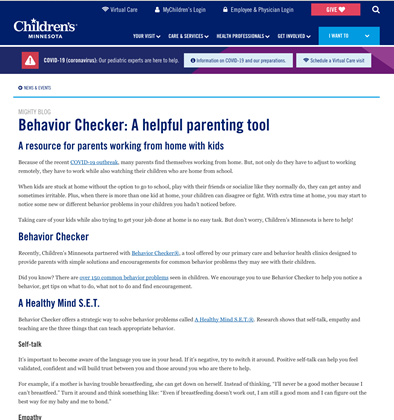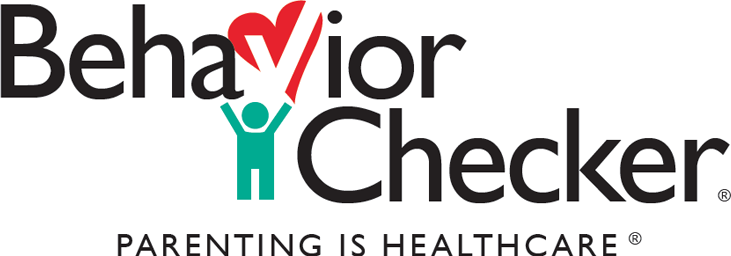Behavior Checker®: A helpful parenting tool

A resource for parents working from home with kids
Because of the recent COVID19 outbreak, many parents find themselves working from home. But, not only do they have to adjust to working remotely, they have to work while also watching their children who are home from school.
When kids are stuck at home without the option to go to school, play with their friends or socialize like they normally do, they can get antsy and sometimes irritable. Plus, when there is more than one kid at home, your children can disagree or fight. With extra time at home, you may start to notice some new or different behavior problems in your children you hadn’t noticed before.
Taking care of your kids while also trying to get your job done at home is no easy task. But don’t worry, Children’s Minnesota is here to help!
Behavior Checker
Recently, Children’s Minnesota partnered with Behavior Checker®, a tool offered by our primary care and behavior health clinics designed to provide parents with simple solutions and encouragements for common behavior problems they may see with their children.
Did you know? There are over 150 common behavior problems seen in children. We encourage you to use Behavior Checker to help you notice a behavior, get tips on what to do, what not to do and find encouragement.
A Healthy Mind S.E.T.®
Behavior Checker offers a strategic way to solve behavior problems called A Healthy Mind S.E.T.®. Research shows that selftalk, empathy and teaching are the three things that can teach appropriate behavior.
Self-talk
It’s important to become aware of the language you use in your head. If it’s negative, try to switch it around. Positive selftalk can help you feel validated, confident and will build trust between you and those around you who are there to help.
For example, if a mother is having trouble breastfeeding, she can get down on herself. Instead of thinking, “I’ll never be a good mother because I can’t breastfeed.” Turn it around and think something like: “Even if breastfeeding doesn’t work out, I am still a good mom and I can figure out the best way for my baby and me to bond.”
Empathy
Once you have mastered positive selftalk, it’s time to move on to step 2: Empathy. Empathy is the ability to understand others’ feelings in addition to our own. If you are upset about your child’s behaviors, try and empathize with them.
Behavior Checker suggests you think about your child’s needs instead of reacting to their behavior. For example, if you are frustrated with your child’s bathing behavior, try thinking about it this way: “I can empathize with my baby because I can imagine how frustrating it is for her not to be able to splash and play as much as she wants.”
Teach
You will teach your children many things during your lifetime. But it’s important to teach them not only rules, but also how to manage those rules.
For example, when teaching your child to go to bed at a certain time, make sure to pay attention to any negative selftalk that may creep in during the teaching process. Remember to empathize with your child during this process as well.
Think about how you learn best and use that strategy to teach your child. If encouragement works best for you, try that. Or if rewards helped you learn easier, use that strategy. You know your child better than anyone, so think about how they would learn best and use that strategy to teach them about their bed time.
Behavior Checker is a resource for all parents with children who have any of the common behavior problems seen in many kids. During this time while we are all stuck at home, remember this tool.
More information about A Healthy Mind S.E.T.® and Behavior Checker® can be found on their website.
© 2020 Children’s Minnesota
Children's Minnesota is registered as a 501(c)(3) nonprofit organization.
Our tax identification number is 411754276
